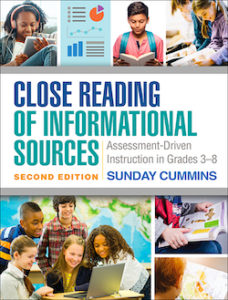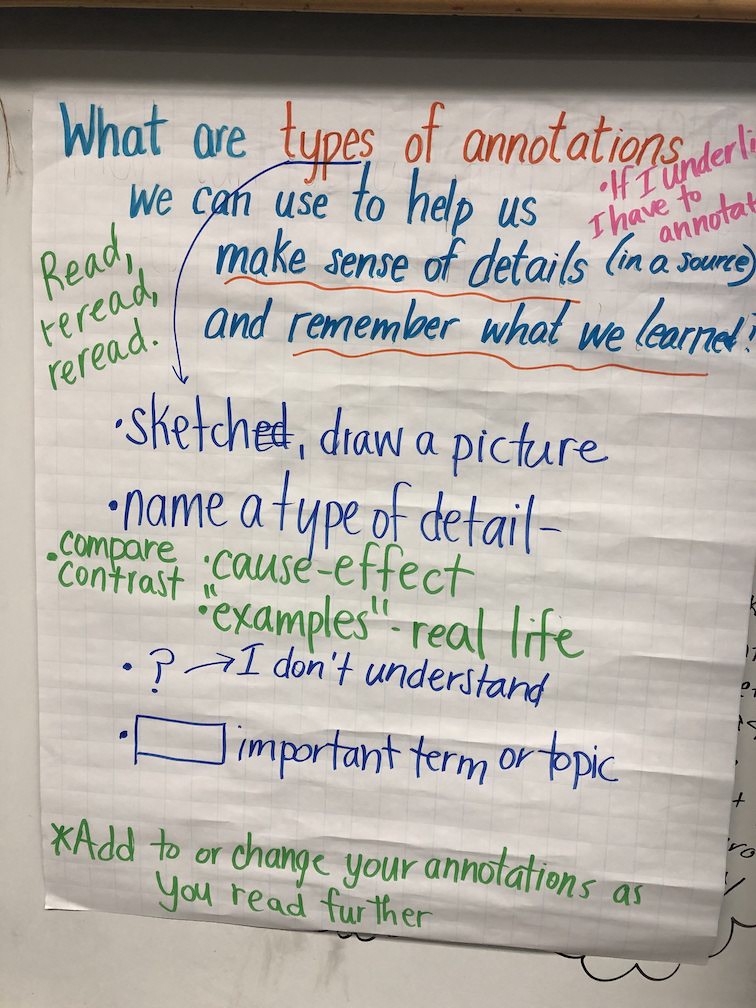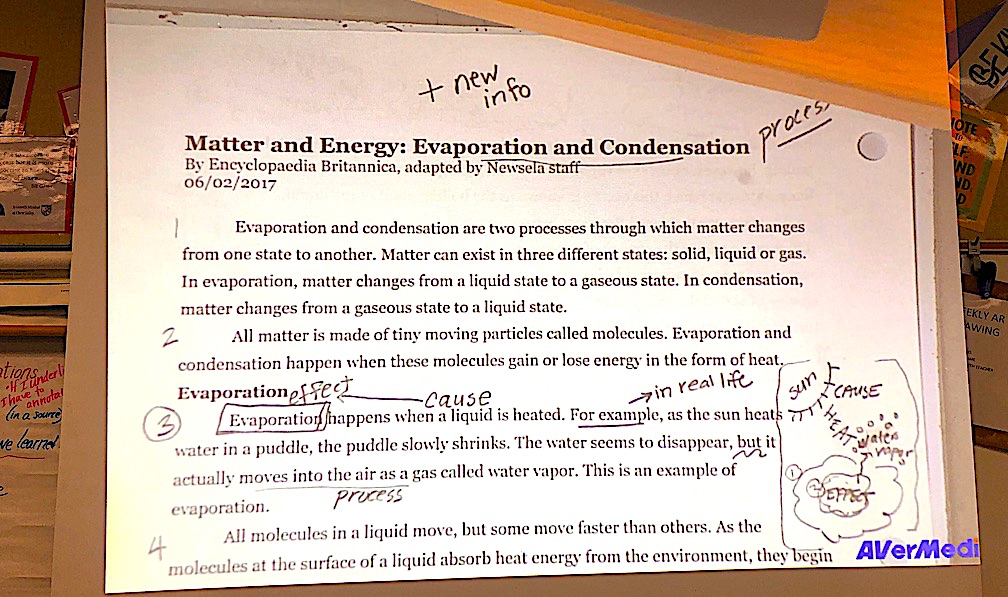4 Keys to Helping Students Annotate Texts
 By Sunday Cummins
By Sunday Cummins
Are your students’ annotated texts hard to make sense of? Do they underline entire sections of a source? And write very few comments?
This kind of annotating can be a waste of time and a huge impediment to meaningful learning for some of our learners. How can we turn this around?
A general rule for me is to ask students to read a source the first time without annotating. This allows them to get the gist of the source, a sense of how it’s structured, and the author’s purpose.
This knowledge will help them as they return to the source or parts of the source to closely read and annotate. Then as students annotate texts during lessons, I integrate the following four approaches.
1. Make sure students have a clear purpose for annotating.
Some students may not understand what we are asking when we tell them to underline and annotate “key details” or “what’s important” in a source. I remember one student told me he’d underlined the entire page of a text because he thought “it was all important.” To avoid this, make sure the students always have a clear purpose for reading and annotating, a purpose that can easily be stated as a question.

► What are details I’m reading that I already know about this topic? What are details I didn’t know?
► I think the main idea is ________ so what are details that help me explain this main idea better?
► The author’s purpose seems to be to ___________ so what are details that help me confirm that purpose?
► What were obstacles the new U.S. government faced under the Articles of Confederation?
► How did the resistance fighters reveal their courage?
A clear purpose can act as an important guide or filter for students. As they try to determine which parts are worthy of annotation, they can ask themselves, “Which details help me respond to my purpose for reading?”
2. Ask students to jot a note anytime they underline or highlight.
This requirement can nudge students to be more judicious in choosing what (or how much) to underline. Sometimes a student will have a sense that a part of a source is important and needs to be underlined, but they do not know what to write. Questions they can ask themselves include:
► What does this detail tell me that’s important?
► What am I learning from this detail?
► How is this detail related to my purpose for reading?
Another option is to generate a list of “types of annotations” as students practice annotating texts. The image below is a chart I generated with a group of students as we annotated a complex source about evaporation and condensation.
If students can name a type of annotation (e.g., “sketching to create a picture in mind” or “naming a type of detail like cause-effect”) then they are more likely to use that type of annotation to help them make sense of details in a text.
3. As you demonstrate, think aloud for students about your decisions to annotate or not to annotate.
Students need to hear you think aloud as you annotate a text. They need to hear not only what you are thinking, but they also need to hear how you decided which words to actually write in an annotation. This image is from a lesson on evaporation and condensation. Our purpose for reading was to name the types of details the author used to explain these two concepts—as a way to help us explain what we learned.
Part of my think aloud sounded like this:
The author writes, “Evaporation happens when a liquid is heated.” I noticed the words “happens when” and that made me realize that this is a cause and effect. I think the author wants me to know that evaporation is caused when a liquid, maybe like water, gets hot. To help me remember this, I’m going to write the word “effect” above the word “evaporation” and “cause” above the phrase “when a liquid is heated.” These notes will help me remember what I was thinking when I read this sentence.
Students also need to hear what you’re thinking when you make a decision not to annotate a section. In the last sentence of that paragraph about evaporation, the author states, “This is an example of evaporation.” This sentence states information I’d already thought through in the previous sentences and didn’t need to think much about again so I said to the students:
I’m not going to underline anything in this sentence or write a note because I already thought through this in the previous sentences. The author is just restating what he stated earlier.
4. Ask students to notice and name the value of annotating.
Sometimes we need to ask our students, “How was annotating helpful to you today?” because they may not realize the benefits. Some of the benefits include the following:
► Annotating while reading (with a clear purpose) can help us
– remember what we read.
– slow down and really think about what we do and do not understand in a source.
– make sense of a complex part of a source.
► The thinking we do while annotating can lead to questions about what’s missing in a source and/or questions that are worthy of additional research.
► Being able to look back at annotations can help us explain to others what we have learned.
► Being able to look across our annotations can help us synthesize the big ideas in a source.
► Looking at the details we underlined and our annotations can help us determine what we need to include in a presentation or a written response.
Learning how to annotate in a mindful way can expand our students’ ability to make sense of complex sources and, as a result, the world around them. With some purposeful planning, we can help them sharpen this critical skill and move forward in their learning.

Sunday is the author of several professional books, including her latest releases, Close Reading of Informational Sources (Guilford, 2019), and Nurturing Informed Thinking (Heinemann, 2018).
She’s is a graduate of Teachers College, Columbia University, and has a doctorate in Curriculum and Instruction from the University of Illinois, Champaign Urbana. Visit her website and read her regular blog posts on teaching information literacy. Follow her on X-Twitter @SundayCummins.




































Annotating certainly needs a purpose and some modeling. Thanks for highlighting and sharing this. One way to explain it to students: you are shopping for information and annotations are what you want to keep in your cart.